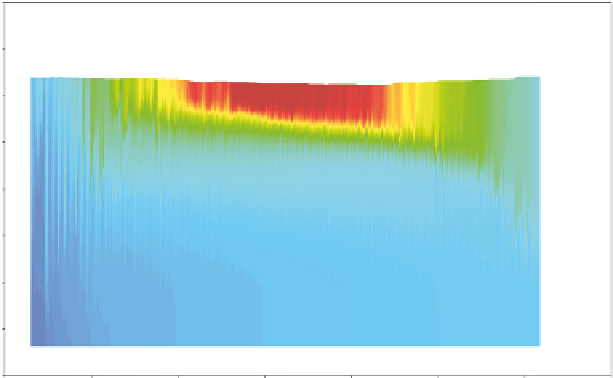Environmental Engineering Reference
In-Depth Information
140
Te mperature
(°C)
130
0
120
5
110
10
100
15
90
20
80
25
70
30
60
50
100
150
200
250
300
350
400
Day
FIGURE 12.17
1980 temperature time-vertical contours for DeGray Reservoir from near the dam.
Martin and McCutcheon 1999). In these plots (Figures 12.17 and 12.18), the seasonal heating of the
epilimnion can be seen more clearly, along with periodic intervals of convective mixing, such as at
nighttime. This is also a peaking hydropower reservoir and the operation of the reservoir can impact
mixing as well. The longitudinal-vertical proile plots (Figure 12.18) show that water temperatures
are usually reasonably uniform horizontally, as would be expected since changes are largely due to
surface transfers. Some variations can be seen, such as those due to inlow temperatures and other
factors impacting transport, which will be discussed in Chapter 13. The differences are often suf-
icient to result in strong longitudinal gradients in other water quality parameters.
A second example is illustrated in Figure 12.19 for Folsom Lake, California (Bender et al. 2007),
also using the results from the CE-QUAL-W2 model. Folsom Lake becomes thermally stratiied each
spring and maintains a separation between the warmer epilimnetic waters and the cold-water pool
comprising the hypolimnion. Thermal stratiication usually begins in April and continues through
the summer and into November when winds and inlow begin to mix the top and bottom layers.
12.6 CLASSIFICATION BASED ON MIXING
Lakes and reservoirs are often classiied based on stratiication patterns, whether they mix com-
pletely during the year, and if so, how many times. The number of mixing events and the degree to
which mixing occurs often has a direct impact on water quality.
The general mixing characteristics of lakes may often be related to their location (e.g., latitude
and elevation), as summarized in Figure 12.20, while the mixing characteristics of reservoirs often
depend on their structure and operation. One distinction is based on whether the entire lake or res-
ervoir mixes during a year, or only part thereof:
•
Holomictic: refers to lakes and reservoirs in which the entire water column completely
mixes during the year.
•
Meromictic: refers to those relatively rare lakes and reservoirs that do not mix completely.
They often have a deep stratum that is completely stagnant and often anaerobic. Meromixis
can result, in part, due to lake bathymetry, for example, where it minimizes the impacts of
wind mixing. Meromixes can also result, in whole or in part, from chemical, biological, or
physical effects, and are subsequently referred to as (Hutchinson 1937):


Search WWH ::

Custom Search